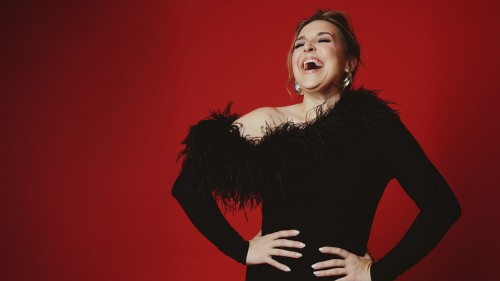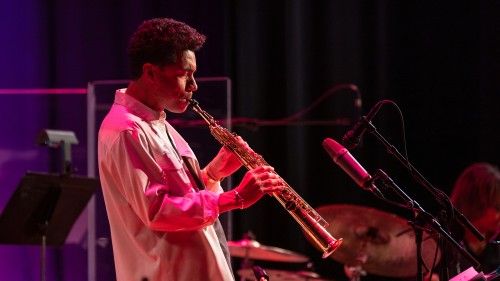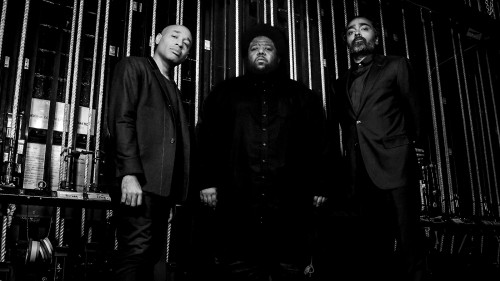
Théo Ould, accordion
In the Footsteps of Piazzolla
Debut Series
This site uses cookies to measure our traffic and improve your experience. By clicking "OK" you consent to our use of cookies.
Save 25-50% now on Winter shows, and get early access (and big savings) for select Spring events, including Alvin Ailey American Dance Theater!
The magnificent Berliner Philharmoniker returns to Symphony Hall under the baton of Chief Conductor Kirill Petrenko, revealing the intricacies and majesty of Bruckner’s monumental Fifth Symphony. Renowned for their clarity and roster-wide virtuosity, the orchestra draws out every detail of Bruckner’s writing: evocative and questioning woodwinds, spacious brass, and propulsive strings.
Petrenko, now in his fifth season and second Boston appearance with the ensemble, continues the Berlin tradition of interpreting and championing Bruckner. For more than a century, the composer, an organist by training, has been central to the Philharmoniker’s performance and recording identity.
Movement by movement, Kirill Petrenko and the Berliner Philharmoniker expertly build one of Bruckner’s “cathedrals of sound,” culminating in a powerful and transcendent finale that illuminates the whole mighty structure.
The Fifth Symphony is a work with which the composer fought for public recognition. In it, he reveals himself to be a gifted musical architect, bringing together voluptuous melodies, solemn chorales and sophisticated contrapuntal structures to create a symphonic monument. Kirill Petrenko conducts Bruckner with the Berliner Philharmoniker for the first time.
Here is the full program note:
Anton Bruckner’s symphonies have often been likened to cathedrals because of their immense proportions and their solemn and majestic bearing. The composer, born in Ansfelden, Austria, 200 years ago this year, was educated at the monastery of St. Florian outside Linz, whose imposing basilica, a wonder of Baroque architecture, was a defining experience of his life. Bruckner started there as a choirboy, and later served as organist for the church. He eventually moved to Linz and later lived in Vienna for many years, yet it was at St. Florian that he was buried in 1896.
Bruckner’s strong religious faith was a major inspiration for all of the symphonies, but it may be felt in the Fifth to an even greater extent than usual. Some have called the work the ‟Glaubenssinfonie” (‟Symphony of Faith”); Bruckner himself referred to it as the ‟Fantastic,” mainly on account of its finale, clearly an extraordinary achievement, which Bruckner saw as his ‟contrapuntal masterpiece.” The work, completed in 1878, had to wait a full sixteen years for its premiere; its only performance during the composer’s lifetime took place in the city of Graz in 1894. Bruckner, prevented from attending by illness, never heard his ‟Fantastic” performed.
The Fifth is the only Bruckner symphony to formally open with a slow introduction. I say ‟formally” because at first hearing the effect is not strikingly different from the openings of other symphonies, consisting of what the great Bruckner authority Robert Simpson once described as ‟tempo-less [shimmering] tremolandi, spanning the space between silence and Bruckner.” The bass pizzicati (plucked notes) of the Fifth, above which a slow string melody unfolds in imitation, have a similar effect of sound emerging from silence. The contrast between a slower and a faster tempo will become important only later, when the slow tempo returns during the development section, and then at the beginning of the finale, which begins in exactly the same way as the first movement.
The Adagio introduction presents the germs of two of the work’s most important melodic types: a fanfare and a chorale. Both will be extensively developed in the course of the symphony.
The first movement follows the classical outlines of sonata form, with a three-theme exposition, development and recapitulation, but each of these components are worked out on an unusually broad scale, with pauses between the sections, and mighty crescendos drawn out over many measures. Extremely soft, whispered passages alternate abruptly with powerful outbursts, the last one of which—the most grandiose of all—ends the movement in a monumental blaze of sound.
The second-movement Adagio is based on two melodies that we may call ‟A” and ‟B”; the form of the movement can, then, be described as A-B-A-B-A. Melody ‟A,” a theme in duple meter, has an accompaniment in triple time, resulting in a metric ambivalence made even more conspicuous by the slow tempo. All ambivalence disappears in the gentle ‟B” theme, played by the violins and developed in contrapuntal imitation. The ‟A” melody returns with figurations added, followed by a variation of ‟B.” Finally, ‟A” comes back with even more elaborate embellishments, and the movement dies away as, on the last pianissimo repeat, the melody suddenly switches from minor to major. (Bruckner’s model was evidently the third movement of Beethoven’s Ninth Symphony, which follows the same formal outline.)
The Scherzo is linked to the second movement by a shared motif: the triplet accompaniment from the Adagio becomes the background for both of the Scherzo’s themes. The first theme, rhythmical and energetic, is played by the woodwind; the second, slower, gentler, and reminiscent of the traditional Austrian Ländler dance, is given to the violins. The two themes alternate as Bruckner weaves them into a sonata-like structure with exposition, development, and recapitulation. The Trio, or middle section, has a simple and gentle melody that remains delightfully unsophisticated despite some interesting harmonic and contrapuntal manipulations. After the Trio, the Scherzo is repeated in its entirety, as tradition demands.
The grandiose finale fuses two different forms: it is part sonata, with its succession of contrasting themes, and part fugue, with a single theme developed in contrapuntal imitation. The movement starts with an introduction that once again harkens back to Beethoven’s Ninth: like in that work, quotes from earlier movements appear. A brief motif played by the clarinet, which initially sounds rather humorous and irreverent, subsequently becomes the subject of a splendid fugue. Later a second theme appears; it, too, employs contrapuntal techniques. Eventually, a chorale-like theme appears and comes to dominate proceedings more and more as the symphony progresses. It is combined with the fugal first theme, which is also presented in inversion (with the ascending intervals transformed into descending ones and vice versa). At the climactic point, the first theme of the first movement returns to unify the entire symphony; the last word, however, belongs to the chorale, finally presented by the full orchestra. The final measures are an expanded version of the first movement’s conclusion, reaching what one scholar has called a ‟plateau of intensity,” a prolonged stay on the emotional high point whose emotional effect lingers on long after the symphony has ended.
- Peter Laki
“Even at the very top of the field, playing this spectacular—this virtuosic, colorful, confident, unified and committed—is vanishingly rare. ”
Zachary Woolfe, The New York Times

In the Footsteps of Piazzolla
Debut Series

SLEIGH

PEACE

featuring youth ensembles from Boston Music Project, City Strings United, and Project STEP


Songs from My Fair Lady, Camelot, and Brigadoon: Lerner & Loewe’s Greatest Hits
Stay in touch with Celebrity Series of Boston and get the latest.
Email Updates Sign up for Email Updates